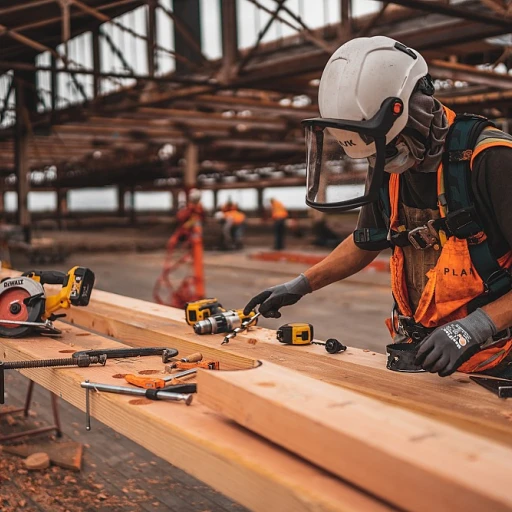
The Rise of Virtual Reality in Workplaces
Exploring the Emergence of VR in Professional Settings
The workplace is experiencing a powerful transformation with the advent of virtual reality (VR), attracting a growing interest from both innovators and experts in the field. This immersive technology is no longer confined to gaming industries; it has incubated new possibilities in various professional domains, including work performance evaluation. As more businesses and employees recognize the potential, VR proves to be a groundbreaking tool in the realm of performance reviews and training.
Particularly, VR offers a dynamic environment that enhances the traditional employee performance assessment process. By simulating realistic work challenges, it presents a compelling mechanism for collecting data-based insights on cognitive and physical activities. This is not only beneficial for younger employees but also older adults, allowing them to engage in community dwelling and experience-based learning, ultimately improving cognitive function.
Furthermore, immersive environments, such as those powered by devices like the HTC Vive, provide a unique platform for participants to undertake performance evaluations through action tests. Randomized controlled scenarios can significantly contribute to more accurate performance reviews when compared to conventional methodologies.
The implications of VR-based evaluations are profound. Virtual workplaces cater to the needs of diverse employees, offering a different approach to training and skill assessments. The implementation of VR promotes structured training through physical cognitive activities, enhancing the overall employee experience. Importantly, companies leveraging this digital transition can optimize their workforce management, resulting in more efficient performance outcomes.
For more insights into how interactive technologies are influencing future workplace trends, you can read an article on the role of interactive technologies in shaping workplace dynamics.
Benefits of VR in Work Evaluation
The Advantages of Employing Virtual Reality in Performance Reviews
Virtual reality (VR) is rapidly gaining traction in various domains, and its application in evaluating employee performance is notably transformative. The immersive experience provided by VR allows for comprehensive assessments, enhancing traditional performance reviews in numerous ways.
Immersive Cognitive Evaluation: The use of VR not only allows for the assessment of cognitive functions through simulations but also offers an interactive environment that can measure physical activity and cognitive function in a more dynamic manner than conventional methods. This is particularly beneficial for evaluating tasks that require a combination of cognitive and physical skills, akin to video game performance tests. Systematic reviews suggest that VR can especially aid in assessing older adults, providing insights into both cognitive engagement and physical capabilities.
Data-Driven Insights: VR systems can collect an extensive range of data during employee interactions within a virtual environment. These data points, which can cover everything from task completion to cognitive responses, allow for a granular analysis akin to a meta-analysis in scientific studies. System usability evaluations indicate that the feedback gathered is comprehensive, enhancing the depth of performance reviews.
Training and Development: One of the intrinsic benefits of VR is its potential as a training tool. It allows employees to partake in action tests and randomized controlled simulations that can identify areas of improvement while also serving as a training mechanism. This is particularly useful for community-dwelling older adults and can lead to improved long-term performance outcomes.
A systematic review of VR applications in employee performance evaluations highlights its efficacy in providing immersive training experiences that can enhance both physical and cognitive performance. Given these advantages, it becomes clear that VR not only enhances the review process but also contributes to overall employee development, which is a stepping stone toward integrating emerging trends and luxury teaching technologies. Luxury teaching technologies and emerging trends are integral to shaping the future of work.
Challenges and Limitations
Addressing the Unique Challenges of Virtual Reality
Embarking on the journey of integrating virtual reality (VR) into work performance evaluations presents a unique set of challenges and limitations. While virtual reality holds immense promise in transforming the landscape, there are aspects that need careful scrutiny and enhancement. One significant challenge lies in ensuring the accessibility and usability of VR systems for all employees, particularly older adults. A systematic review of VR in workplaces suggests that while newer generations find the transition to immersive environments seamless, older employees may experience difficulties due to unfamiliarity with such technologies. This can compromise their performance reviews unless adequate training and support are provided. Another hurdle is cognitive function adaptation. The transition from traditional evaluations to VR-based assessments can be cognitively demanding. Studies have indicated that cognitive load can affect employee performance during VR assessments, particularly if the virtual environments are complex or if employees have limited experience with video games or similar interfaces. Technical limitations can also impede the process. The quality of virtual reality hardware, such as HTC Vive, and software can significantly affect the immersiveness and accuracy of evaluations. Inaccuracy in data collection and participant feedback can lead to skewed performance reviews. Issues like system usability, connectivity problems, and equipment malfunctions need addressing to prevent interruptions. Privacy and data security concerns also loom large over VR applications in work evaluations. With data being continuously generated and collected, ensuring its protection from breaches and unauthorized access is critical. Employees must be assured of the security of their personal data to foster trust in VR assessments. Considering these challenges, it is vital for organizations to conduct a thorough review of their virtual systems and employee training programs. A well-planned approach can mitigate these limitations and pave the way for a successful integration of virtual reality in work evaluations. Organizations must remain committed to refining VR systems and aiding participants in adapting to these new environments to harness the full potential of a future with VR-augmented cognitive and performance assessments.Case Studies and Success Stories
Exploring Notable Applications: Virtual Reality in Work Performance Evaluation
The field of virtual reality in employee performance evaluation has been a hotbed of innovation, with numerous organizations and researchers undertaking studies to explore its potential. These case studies and success stories offer a glimpse into how VR can transform performance reviews by providing immersive experiences that traditional reviews often lack. One notable example involves the use of VR for training and evaluating older employees. By immersing participants in virtual environments, companies have observed improvements in both cognitive and physical functions. Research cited in platforms like Google Scholar and PubMed highlights the effectiveness of VR-based cognitive training in boosting cognitive function among older adults. This approach not only aids in skill development but also makes performance evaluation more engaging. Employers seeking to streamline their employee performance review processes have reported success when integrating VR technology. A systematic review of video game-based training demonstrated measurable improvements in employee performance, suggesting that virtual environments can foster immediate feedback and development. For instance, combining tools like the HTC Vive with action tests allows for the collection of detailed performance data, which can guide future training initiatives. The utility of VR extends to randomized controlled trials that assess the impact of immersive virtual reality on community-dwelling older adults. These trials underscore VR's role in enhancing long-term training outcomes and improving job-related cognitive tasks, which are crucial for performance reviews. Another valuable insight from these studies is the VR applications' attention to system usability. Creating user-friendly and intuitive VR experiences ensures that employees, regardless of age, can easily navigate these digital realms. Moreover, the data derived from these studies is pivotal in refining VR platforms to better suit workplace needs. As VR continues to evolve, its role in reshaping performance reviews becomes more pronounced, offering a blend of engaging experiences and data-driven insights that drive organizational success.Future Trends in VR Work Evaluation
Emerging Patterns and Future Developments
As the use of virtual reality (VR) for performance reviews continues to evolve, several future trends are emerging that promise to reshape work evaluation processes. These trends are crucial for organizations aiming to optimize employee performance and maintain a competitive edge. Firstly, the integration of immersive technologies is expected to grow significantly. With VR platforms like HTC Vive advancing, employees can participate in more realistic simulations that closely mimic real-world challenges. This immersive experience facilitates better cognitive and physical function assessments, especially beneficial for older adults. Studies underscore the potential of virtual environments in enhancing cognitive performance by providing engaging and interactive employee training modules. Furthermore, emerging data suggests that VR-based evaluations can be coupled with meta-analyses and systematic reviews to provide a more comprehensive understanding of employee capabilities. By using these insights, organizations will be able to tailor individualized training programs that align with the specific needs and cognitive capacities of their workforce. A notable area seeing increased exploration is the use of VR for cognitive function assessments. Research published in sources like PubMed highlights the effectiveness of VR in conducting action tests and physical activity modules, which offer insights into both the physical and cognitive function of employees. This is particularly pertinent for community-dwelling older adults, allowing them to demonstrate their capabilities in a controlled yet challenging virtual situation. Looking ahead, the practice of hosting randomized controlled trials within virtual reality settings for performance reviews will likely become more mainstream. As these trials generate valuable data, they provide organizations with critical insights that inform future training and development strategies. A systematic approach ensures these programs are not only engaging but also tailored based on performance data. In summary, as organizations strive for enhanced system usability and more meaningful evaluations, the future of VR work assessments seems promising. By leveraging VR-based reviews, companies can ensure that their evaluations are both robust and reflective of the diverse capabilities of their employees. As these methodologies continue to evolve, they hold the potential to redefine how organizations measure and boost employee performance.Preparing for the VR Revolution in Work Evaluation
Steps to Embrace Virtual Reality in Work Evaluation
For organizations ready to dive into the world of virtual reality, it's crucial to prepare adequately for this transformative change. Implementing VR-based systems for performance reviews requires a combination of technological adaptation, employee training, and cultural readiness.- Understand the infrastructure needs: Before introducing VR, it's essential to assess the existing technological infrastructure. Many companies will need to invest in VR headsets like HTC Vive or similar devices that offer immersive experiences.
- Develop a training program: Incorporating VR into performance evaluations necessitates employee training. A comprehensive training program can help employees, including older adults, become comfortable with this new technology. Studies have demonstrated the effectiveness of VR training in improving physical cognitive functions.
- Organize pilot programs: Run randomized controlled trials or pilot studies to gather initial data and experience. These can be based on both systematic review of existing literature and your own meta analysis.
- Evaluate system usability: It's vital to regularly review the system's usability. Engage participants in action tests to assess user experience and gather feedback to refine processes.
- Tie into ongoing evaluations: Introduce VR evaluations into existing performance review frameworks. This can help draw a clearer picture by integrating cognitive, physical, and traditional metrics, enhancing employee performance insights.












